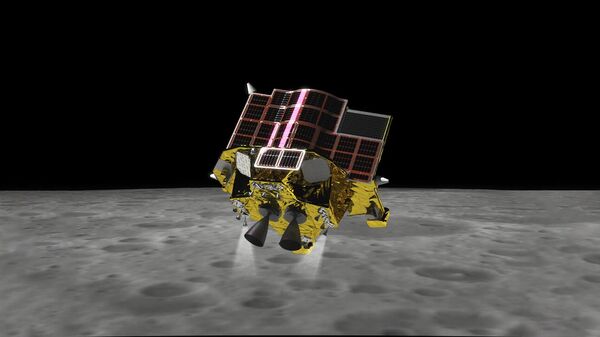
MOSCOW, January 20, Tatyana PichuginaAfter almost five months of travel, the SLIM module landed on the Earth’s natural satellite. However, the status of the mission is unknown. The device is equipped with a high-precision navigation system and is aimed at the slope of the Shiori crater on the visible side of the Moon. What is remarkable about the “lunar sniper” — in the material .
SLIM high-precision landing system
The surface of the Moon has been studied in sufficient detail using orbital observatories. More detailed information about rock outcrops is expected from the landing modules. However, the accuracy of the lunar landing remains low — tens of kilometers. This jeopardizes the entire mission. The rover may not be able to overcome such a distance over difficult terrain to the desired crater. This is especially true in the polar regions, where search areas for water ice are very limited and difficult to access.
In 2011, Japanese scientists proposed the concept of a new generation of landing modules with a high-precision landing system using mapping data from the Kaguya (Japan) and LRO (USA) probes. Smart Lander for Investigating Moon (SLIM), that is, a “smart landing module for exploring the Moon,” is capable of landing on the Moon with an accuracy of meters and even centimeters. He was nicknamed the lunar sniper.
The main goal of SLIM is to show that such a landing is possible. This will open a new stage in the study of our satellite. For example, you can land near a lava tube. For the first time such an object was discovered by a Japanese orbital vehicle in the Marius Hills region. However, how to get to the bottom, to a depth of 50 meters, is still unclear.
The SLIM mission, the third in Japan's small-scale lunar exploration program, was supposed to take place much earlier, but preparations were delayed. To debug technologies, we have identified a new goal — the small Shiori crater on the visible side of the Moon.
The task is to land the device immediately at the intended point. Japan has experience. In 2005, the Hayabusa probe landed on the Itokawa asteroid to collect soil, and in 2018, Hayabusa-2 landed on the Ryugu asteroid. However, in terms of mass, these celestial bodies are not comparable to the Moon; with stronger gravity, everything is more complicated. You need to descend much more slowly and be able to take off again if necessary. This means we need an obstacle avoidance system. No one has ever done this automatically.
In addition, SLIM lands on a slope, so a two-stage landing was provided. At the end of the descent, the device tilts and touches the surface with only part of the bottom supported by the main landing gear. Then it moves forward and lowers completely. Five 3D printed aluminum «patterned» shock absorbers absorb shock.
SLIM compact device
SLIM developers from the Japan Aerospace Agency (JAXA) have created a lightweight and compact lander powered by chemical engines. Everything is miniaturized to the extreme. First of all, the “brains” and the propulsion system are the key elements of lunar missions. The launch weight of SLIM is 730 kilograms, during landing — 190.
The main propulsion system with a ceramic chamber is from Mitsubishi. On two-component liquid fuel, thrust — 500 Newton. Additionally, 12 propulsion modules provide various types of movements, maneuverability, height control.
SLIM is powered by a lithium-ion battery and a thin-film solar panel.
Mission progress and landing site
Late in the evening of September 6, the H-IIA launch vehicle took off from the Tanegashima Cosmodrome in Japan with two scientific devices on board — the X-ray orbital telescope XRISM and the SLIM lander.
The “Lunar Sniper” entered the lunar orbit on October 1, and on December 26 it was adjusted to an elliptical one with parameters of 600 kilometers at the periseleniya, the point closest to the surface, and four thousand kilometers at the aposelenie, the farthest point. Gradually, the orbit was changed to a circular one, lowering the perilunium to 150 kilometers, and on January 19 — to 15. 20 minutes after this, the module began to descend, reducing its speed to 1700 meters per second.
SLIM is aimed at the slope of the Shiori crater inside a large astrobleme Kirill. Its relative youth is indicated by its bright ray structure. Diameter — 210 meters. It contains an even younger impact crater measuring 85 meters.
The crater is formed by the impact of a meteorite or comet on the surface at a speed of about 15 kilometers per second. It is usually ten times larger than the impact body, with a depth of about a fifth. Material is thrown outward, forming a shaft and piles. At Shiori, rocks are estimated to have been ejected from a depth of about 20 meters. And they haven’t completely weathered, that’s why they’re so bright.
12 kilometers from Siori there is also a young 100-kilometer-long Theophiluscrater. This means that in this area you can find rocks from a depth of up to two kilometers and study them without resorting to drilling.
On board SLIM there is a multi-band camera that allows you to understand the composition of the material from the spectrum of reflected sunlight. Scientists are especially interested in the mantle mineral olivine. There is also a small laser retroreflector array from NASA.
The module delivered two mini- rover. Lunar Excursion Vehicle 1, or LEV-1, in addition to the camera, is equipped with a thermometer, radiometer, tilt sensor and an independent communication system with the Earth.
LEV-2, created by JAXA in collaboration with a gaming company, is a spherical robot, slightly larger than a tennis ball, weighing 250 grams. It moves, changing shape.
Both lunar rovers separated from the module a few seconds before landing to remove everything from the side.
SLIM is designed to last two weeks — that's how long a day lasts on the Moon. At sunset, when the main source of energy goes away, the device will go into hibernation. If he survives the moonlit night, it will be a great success.
Exploring the Moon with small automatic vehicles
Previously, only the USSR and the USA were able to land automatic vehicles on the Moon. In 2013, China landed Chang'e-3 with the Yutu rover, and last year India landed the Chandrayaan-3 station.
This is the third attempt for Japan. In December 2022, engineers were unable to communicate with the Omotenashi module, launched along with the Orion spacecraft on the Artemis 1 mission. In April 2023, the Hakuto-R spacecraft, developed by Ispace, crashed during landing due to an error in the program.
In 2019, the Israeli Bereshit probe crashed, and a little later the Indian Pryagyan probe. In August 2023, the same fate befell the Russian Luna-25. And these days, due to an accident in the fuel system, the American private Peregrine mission ended in failure. After a week in emergency mode, the device was returned to Earth and sank in the Pacific Ocean.
In the future, Japan intends to carry out the Lunar Polar Mission (LUPEX), which involves the creation of a sealed lunar rover controlled by a crew of astronauts. Technologies developed on the Moon will be useful for exploring Mars.




















































Свежие комментарии